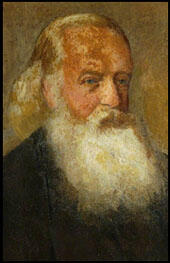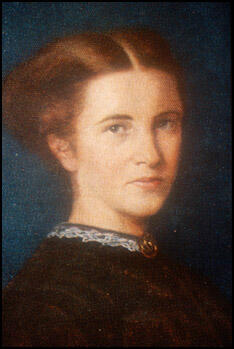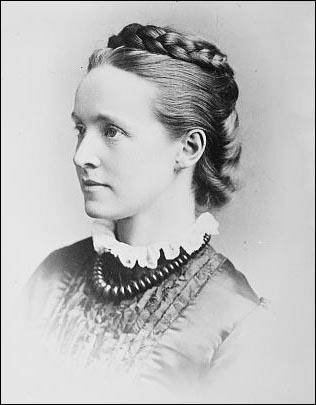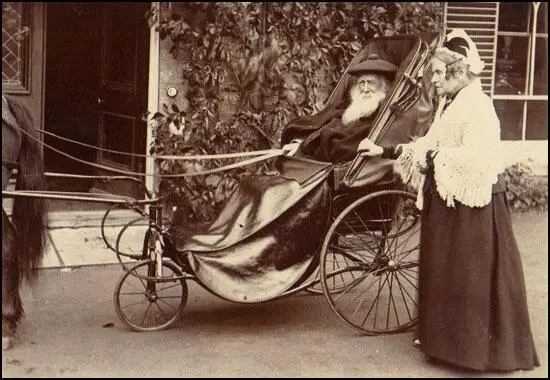Newson Garrett

Newson Garrett, the third son of Richard Garrett (1779–1837), agricultural engineer, and his wife, Sarah, daughter of John Balls, engineer, of Hethersett, Norfolk, was born in Leiston, Suffolk, on 31st July 1812. His grandfather, Richard Garrett, had founded the successful agricultural machinery works at Leiston. (1)
Educated at Grundisburgh School, near Woodbridge, Suffolk, Newson had little interest in his studies. (2) A contemporary described him as fair-haired, of a bright complexion that was in contrast to "his sister and two brothers, who were dark even to the point of swarthiness." (2)
Garrett moved to London and was close to his eldest brother, Richard Garrett (1807–1866), who was to inherit the family business. He was introduced to Richard's father-in-law, John Dunnell, landlord of The Beehive Inn, Crawford Street, Marylebone. On 5 April 1834 Garrett married his younger daughter, Louisa (1813–1903) and for seven years managed Dunnell's pawnbrokers shops. (3)
Louisa Dunnell Garrett gave birth to Louisa Garrett (1835-1867), Elizabeth Garrett (1836–1917), Newson Garrett (1839–1917), Edmund Garrett (1840–1914), Alice Garrett (1842–1925), Agnes Garrett (1845–1935), Millicent Garrett (1847–1929), Samuel Garrett (1850–1923), Josephine Garrett (1852–1925) and George Garrett (1854–1929). (4)
Nelson Garrett: Successful Businessman
In 1838 Nelson Garrett decided to return to the healthier climate of Suffolk. Three years later he purchased the Snape corn and coal merchant's business and shipping interests of Robert Fennel and settled his wife and young family at The Uplands, in Aldeburgh. Garrett's business grew fast. "Within three years he was sending about 17,000 quarters of barley to London and Newcastle. He was soon building his own barges and in 1848 was appointed agent for Lloyds. He constructed a gasworks, acquired a local brickworks and built numerous cottages. In 1852 he built Alde House, an impressive mansion overlooking the town of Aldeburgh (complete with ice-house and turkish bath), and two years later designed and built maltings at Snape Bridge. In 1859 the capacity of the maltings was doubled, and the adjoining Bridge House, the family's winter residence during the malting season, completed." (5)
Despite his substantial shipping interests Garrett was keenly aware of the potential of the railways and, by guaranteeing regular freight, persuaded the East Suffolk Railway Company to extend a private line to his maltings. As one of his daughters pointed out: "My father had built up a considerable malting business at Snape: it was conveniently situated on the Alde, so that malt and other things could be shipped thence: and when railways became a practical proposition in our part of Suffolk my father exerted himself successfully to get a branch line, for goods only, extended to Snape." (6)
Newson Garrett "was strikingly handsome, self-confident, and impetuous." (7) According to one contemporary, William Thompson: "In Mr. Garrett a strong will and unfailing courage were added to a temperament almost overloaded with enthusiasm, energy, and activity. None of his virtues were passive." (8)
Newson fell out with his brother, Richard Garrett over the subject of politics. Newson, who was originally a supporter of the Conservative Party became a Liberal Party radical. Millicent Garrett pointed out: "My father, until he was past middle life, believed himself to be a Conservative, but he was not in the least a Conservative in temperament." (9) Despite the fact that their wives were sisters, they are said not to have spoken to each other for thirty years. (10)
Louisa Garrett Smith
Newson's radicalism was shown in his support for women's rights. In December 1859 his eldest daughter, Louisa Garrett Smith joined forces with Emily Davies, Helen Blackburn, Barbara Bodichon, Sophia Jex-Blake, Frances Power Cobbe, Jessie Boucherett and Emily Faithfull to form the Langham Place Group. Davies refused to be secretary because she thought it was prudent to keep her own name "out of sight, to avoid the risk of damaging my work in the education field by its being associated with the agitation for the franchise." Louisa agreed to take on the role of secretary and figurehead. (11)
His second daughter, Elizabeth Garrett, also joined the Langham Place Group. The group played an important role in campaigning for women to become doctors. They arranged for Elizabeth Blackwell, the first woman in the United States to qualify as a doctor, to give a lecture entitled, "Medicine as a Profession for the Ladies". After this lecture Garrett set about obtaining a medical education and a registrable medical qualification, but she faced many difficulties." (12)
Elizabeth Garrett Anderson
Elizabeth Garrett had a strong desire to become a doctor. One of Newson's daughters later commented: "I think the most remarkable thing he ever did was to give active help and support to my sister Elizabeth, then aged about twenty, to enter the medical profession: at the time, of course, all the usual methods of entering the profession were not only closed, but barred, banged, and bolted against women. These bars and bolts a young inexperienced girl, aided by her father, a country merchant, proposed to destroy and throw the gates open. My mother gave no help: she not only was unsympathetic, but intensely averse to the proposal." (13)

Mary Ann Elston has pointed out: "She applied to enroll formally as a medical student at several London teaching hospitals and to matriculate at the universities of Edinburgh, St Andrews, and London. All these attempts were unsuccessful except for a brief period in 1860–61 at the Middlesex Hospital in London, where pressure from some of the male students, possibly jealous of her academic prowess, led to her being excluded from further study there." (14)
In 1862 members of the Langham Place Group got together to form a committee to campaign for women's entry for university examinations. This included Louisa Garrett Smith, Frances Power Cobbe, and Emily Davies. The initial campaign was to help Elizabeth Garrett in her application to matriculate at London University. (15) In 1865 she obtained the licence of the Society of Apothecaries which entitled her to have her name entered on the medical register, the first woman qualified in Britain to do so. She remained as such on the medical register until 1876. (16)
Agnes Garrett
In 1874 Agnes Garrett and her cousin Rhoda Garrett, became the first British women to open an interior design business. The company, called R & A Garrett, designed furniture, chimney-pieces, and wallpapers in the Queen Anne style and aiming at middle-class people with moderate incomes... Among their commissions were the new women's university colleges." (17) One of their first commissions was to decorate 4 Upper Berkeley Street, the home of Elizabeth Garrett Anderson. They were to go on to successfully decorate many private houses. (18)
In May 1875, Rhoda and Agnes moved into 2 Gower Street on the corner of Bedford Square, Bloomsbury. Maude Parry: later pointed out: "Lady pupils in an architect's office being a thing altogether undreamt and unheard of. Having learnt their trade, they soon established themselves as decorators in 2, Gower Street, their firm being the first and only one registered for ladies. A cottage room exhibited by them in the Trocadero at the French Exhibition of 1878 gained very general admiration for its original and simple style; and the Miss Garretts after long protracted and patient work attained that success which was so justly their due." (19)
In 1876 Agnes and Rhoda published their book, Suggestions for House Decoration in Painting, Woodwork, and Furniture. In a letter to the publisher, Alexander Macmillan, Rhoda explained the contents of the book: "An account of the more simple ways in which, without great expense, a home might be made pretty & also wholesome; with designs & illustrations of furniture the whole to consist of a kind of narrative, in which a house is described on which a great deal of money has been spent with a bad result, and the simple cheap way in which the same house may be made to look well." (20) The book was extremely successful and six editions appeared over the next three years. (21)
Millicent Garrett Fawcett
Millicent Garrett Fawcett wrote articles on women's education and women's suffrage. Her short textbook, Political Economy for Beginners (1870), ran into ten editions and was translated into many languages. She also co-authored a book with her husband, Henry Fawcett, entitled, Essays and Lectures on Social and Political Subjects (1872). Millicent had been inspired by the writings of Mary Wollstonecraft and John Mill. (22)

Millicent Garrett Fawcett went on speaking tours on behalf of the women's movement. Her most popular lecture, Electoral Disabilities of Women attempted to deal with all the main objections to women having the vote. For example: (i) Women are sufficiently represented already by men, and their interests have always been jealously protected by the legislature. (ii) A woman is so easily influenced that if she had a vote it would practically have the same effect as giving two votes to her nearest male relation, or to her favourite clergyman. (iii) Women are so obstinate that if they had votes endless family discord would ensue. (iv) The ideal of domestic life is a miniature despotism - one supreme head, to whom all the other members of the family are subject. This ideal would be destroyed if the equality of women with men were recognised by extending the suffrage to women. (v) Women are intellectually inferior to men. (23)
In the 1860s the very idea of a woman standing on a public platform was considered shocking. She found the experience difficult and although she always maintained an air of calm while on the platform, she professed not to enjoy this aspect of the work. Apparently she was so nervous before a speech that she was often physically ill. In an effort to cope with this problem she refused to speak either more than once a day or more than four times a week. (24)
Millicent Fawcett received a great deal of criticism for her public speaking. One man wrote: "I wish to observe that if you purchase a Bible and carefully read its teaching you will arrive at a better conclusion as to the intentions of the Great Creator as to the relation which should exist between the sexes than you will by reading the writings of J.S. Mill who seems to be the chief apostle of the woman suffrage question. I can only say that in my estimation no Christian woman who properly considered her sex and the Divine intention respecting her would take any direct part in politics." (25)
Last Years
Newson Garrett became a partner in the Bow brewery in London. In 1882 the brewing company (one of the earliest to take company status) was registered as Smith, Garrett & Co. Ltd, with a capital of £450,000, Newson and his son Edmund (who managed the brewery), were among its first directors. Shortly after, the malting business of Newson Garrett & Son was similarly incorporated, with Garrett and his youngest son, George (the manager) as directors. (26)
In 1889, Newson Garrett became the first mayor of Aldeburgh, serving again in 1886 and 1890 and as alderman, 1888–93. He was also Aldeburgh's first county councillor and alderman, 1889–92. His involvement in politics often led to conflict. "It may be supposed that this combination of qualities did not always in a small community make for peace, but below an occasionally, stormy surface Mr Garrett had a great heart, full of love for the town he had known so long and full of deep and kindly sympathy with his fellow-men. He was one in whom the instinct to help, when help was wanted, was unusually strong." (27)
Newson Garrett became a partner in the Bow brewery in London. In 1882 the brewing company (one of the earliest to take company status) was registered as Smith, Garrett & Co. Ltd, with a capital of £450,000, Newson and his son Edmund (who managed the brewery), were among its first directors. Shortly after, the malting business of Newson Garrett & Son was similarly incorporated, with Garrett and his youngest son, George (the manager) as directors. (28)

Newson Garrett died on 4th May 1893, following a heart attack and was buried in St Peter and St Paul's Church, Aldeburgh , where there is a commemorative plaque on the wall. He left £57,801 7s. 6d. in his will.
Primary Sources
(1) Canon William Thompson, letter to Louisa Garrett (May 1893)
In Mr. Garrett a strong will and unfailing courage were added to a temperament almost overloaded with enthusiasm, energy, and activity. None of his virtues were passive. It may be supposed that this combination of qualties did not always in a small community make for peace, but below an occasionally, stormy surface Mr Garrett had a great heart, full of love for the town he had known so long and full of deep and kindly sympathy with his fellow-men. He was one in whom the instinct to help, when help was wanted, was unusually strong. Everyone in trouble turned to him, certain of aid if he could be given, and certain, too (even when in fault), of generous judgment.
(2) Millicent Garrett Fawcett, What I Remember (1924)
My father, until he was past middle life, believed himself to be a Conservative, but he was not in the least a Conservative in temperament.... I think the most remarkable thing he ever did was to give active help and support to my sister Elizabeth, then aged about twenty, to enter the medical profession: at the time, of course, all the usual methods of entering the profession were not only closed, but barred, banged, and bolted against women. These bars and bolts a young inexperienced girl, aided by her father, a country merchant, proposed to destroy and throw the gates open. My mother gave no help: she not only was unsympathetic, but intensely averse to the proposal.
References
(1) David Simkin, Family History Research (10th August 2023)
(2) Christine Clark, Newson Garrett: Oxford Dictionary of National Biography (23rd September, 2004)
(3) Millicent Garrett Fawcett, What I Remember (1924) page 16
(4) David Simkin, Family History Research (10th August 2023)
(5) Christine Clark, Newson Garrett: Oxford Dictionary of National Biography (23rd September, 2004)
(6) Millicent Garrett Fawcett, What I Remember (1924) page 18
(7) Jo Manton, Elizabeth Garrett Anderson (1965) page 29
(8) Canon William Thompson, letter to Louisa Garrett (May 1893)
(9) Millicent Garrett Fawcett, What I Remember (1924) page 19
(10) Christine Clark, Newson Garrett: Oxford Dictionary of National Biography (23rd September, 2004)
(11) Pam Hirsch, Barbara Leigh Smith Bodichon, Feminist, Artist and Rebel (1998) page 222
(12) Mary Ann Elston, Elizabeth Garrett Anderson: Oxford Dictionary of National Biography (23rd September, 2004)
(13) Millicent Garrett Fawcett, What I Remember (1924) pages 19-20
(14) Mary Ann Elston, Elizabeth Garrett Anderson: Oxford Dictionary of National Biography (23rd September, 2004)
(15) Ray Strachey, The Cause (1928) page 132
(16) Mary Ann Elston, Elizabeth Garrett Anderson: Oxford Dictionary of National Biography (23rd September, 2004)
(17) Serena Kelly, Agnes Garrett: Oxford Dictionary of National Biography (23rd September, 2004)
(18) Graeme Taylor, Rhoda Garrett (2017) page 95
(19) Maude Parry, Rhoda Garrett (1882)
(20) Rhoda Garrett, letter to Alexander Macmillan (11th March, 1876)
(21) Serena Kelly, Agnes Garrett: Oxford Dictionary of National Biography (23rd September, 2004)
(22) Millicent Garrett Fawcett, The Women's Suffrage Movement (1912) pages 5-6
(23) Millicent Garrett Fawcett, Electoral Disabilities of Women (1872)
(24) Fran Abrams, Freedom's Cause: Lives of the Suffragettes (2003) page 181
(25) Annoymous letter to Millicent Garrett Fawcett (11th May, 1871)
(26) Christine Clark, Newson Garrett: Oxford Dictionary of National Biography (23rd September, 2004)
(27) Canon William Thompson, letter to Louisa Garrett (May 1893)
(28) Christine Clark, Newson Garrett: Oxford Dictionary of National Biography (23rd September, 2004)

